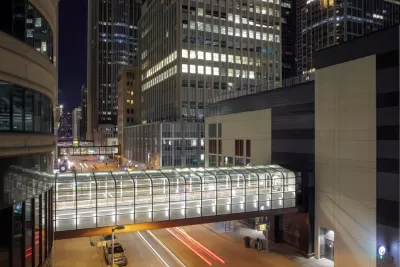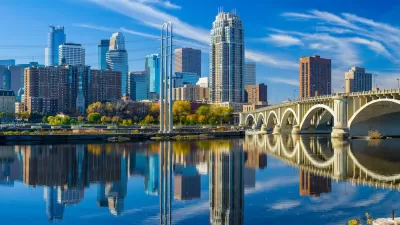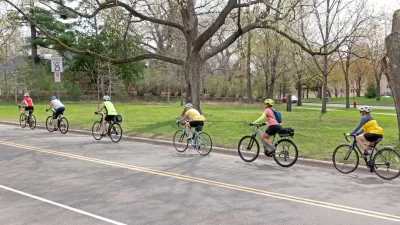Already a source of eternal controversy for their effects on street life and local business, pedestrian skyways have proven even more problematic during the pandemic.

Jake Blumgart reports on the latest developments in the planning of pedestrian skyways—the effects of the pandemic adding new questions about the effects of skyways local retail and public safety.
Blumgart helpfully notes the history of skyway planning and development in the Twin Cities, where this story focuses its attention:
Minneapolis inaugurated the skyway era in 1962 and eventually built out a system with 9.5 contiguous miles of second-story connections between office buildings, hotels and housing towers. St. Paul soon followed, and has five miles of its own. The idea was to compete with suburban office parks and shopping malls, giving aged downtowns an edge — especially in the winter months.
The results, however, have underwhelmed:
From the beginning, skyways were controversial. Critics feared they would imperil existing sidewalk-facing businesses. Today, the streetscape of the two cities is remarkably quiet. With consumer dollars focused on the second floor, street-level stores and restaurants suffer. (It’s worth noting that downtowns as varied as Baltimore and Los Angeles manage a similar deadening effect without skyways.)
The pandemic has accelerated some of the less desirable effects of the skyway approach to downtown circulation. With office emptied out, like they are in so many other cities, the skyways in the Twin Cities have become dark and filled with litter, cigarette smoke, and encampments, according to Blumgart.
The future of the skyways depends on how many people return to the office if and when the public health situation improves, according to the article. While the trends indicate a return to the office, the daytime office population of the Twin Cities is still far below the pre-pandemic precedent.
FULL STORY: The Twin Cities Skyways Face an Uncertain Future

Planetizen Federal Action Tracker
A weekly monitor of how Trump’s orders and actions are impacting planners and planning in America.

Restaurant Patios Were a Pandemic Win — Why Were They so Hard to Keep?
Social distancing requirements and changes in travel patterns prompted cities to pilot new uses for street and sidewalk space. Then it got complicated.

Map: Where Senate Republicans Want to Sell Your Public Lands
For public land advocates, the Senate Republicans’ proposal to sell millions of acres of public land in the West is “the biggest fight of their careers.”

Maui's Vacation Rental Debate Turns Ugly
Verbal attacks, misinformation campaigns and fistfights plague a high-stakes debate to convert thousands of vacation rentals into long-term housing.

San Francisco Suspends Traffic Calming Amidst Record Deaths
Citing “a challenging fiscal landscape,” the city will cease the program on the heels of 42 traffic deaths, including 24 pedestrians.

California Homeless Arrests, Citations Spike After Ruling
An investigation reveals that anti-homeless actions increased up to 500% after Grants Pass v. Johnson — even in cities claiming no policy change.
Urban Design for Planners 1: Software Tools
This six-course series explores essential urban design concepts using open source software and equips planners with the tools they need to participate fully in the urban design process.
Planning for Universal Design
Learn the tools for implementing Universal Design in planning regulations.
Heyer Gruel & Associates PA
JM Goldson LLC
Custer County Colorado
City of Camden Redevelopment Agency
City of Astoria
Transportation Research & Education Center (TREC) at Portland State University
Camden Redevelopment Agency
City of Claremont
Municipality of Princeton (NJ)




























